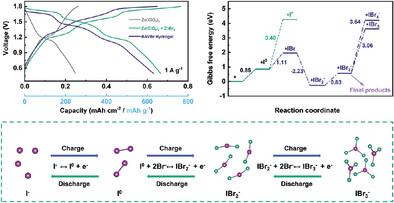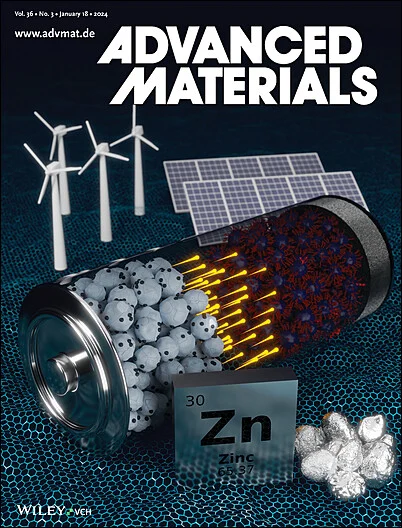All-Climate Energy-Dense Cascade Aqueous Zn-I2 Batteries Enabled by a Polycationic Hydrogel Electrolyte
IF 27.4
1区 材料科学
Q1 CHEMISTRY, MULTIDISCIPLINARY
引用次数: 0
Abstract
The practical development of aqueous zinc-iodine (Zn-I2) batteries is greatly hindered by the low energy density resulting from conventional I0/I− conversion and the limited temperature tolerance. Here, a temperature-insensitive polycationic hydrogel electrolyte borax-bacterial cellulose / p(AM-co-VBIMBr) (denoted as BAVBr) for achieving an energy-dense cascade aqueous Zn-I2 battery over a wide temperature range from −50 to 50 °C is designed. A comprehensive investigation, combining advanced spectroscopic investigation and DFT calculations, has revealed that the presence of Br species in the gel electrolyte facilitates the conversion reaction of Br0/Br−. Simultaneously, it activates the high voltage I+/I0 redox reaction through interhalogen formation. Consequently, sequential and highly reversible redox reactions involving I0/I−, I+/I0, and Br0/Br− are achieved with the assistance of −NR3+ units in BAVBr, effectively suppressing interhalogen hydrolysis in aqueous electrolyte. The cascade reactions lead to a high area capacity of 0.76 mAh cm−2 at a low I2 loading of 1 mg cm−2 or 760 mAh g−1 based on the mass of iodine, demonstrating exceptional long-term cycling stability over a wide temperature range from −50 to 50 °C. This study offers valuable insights into the rational design of electrolytes for high-energy aqueous batteries, specifically tailored for wide-temperature operation.

求助全文
约1分钟内获得全文
求助全文
来源期刊

Advanced Materials
工程技术-材料科学:综合
CiteScore
43.00
自引率
4.10%
发文量
2182
审稿时长
2 months
期刊介绍:
Advanced Materials, one of the world's most prestigious journals and the foundation of the Advanced portfolio, is the home of choice for best-in-class materials science for more than 30 years. Following this fast-growing and interdisciplinary field, we are considering and publishing the most important discoveries on any and all materials from materials scientists, chemists, physicists, engineers as well as health and life scientists and bringing you the latest results and trends in modern materials-related research every week.
 求助内容:
求助内容: 应助结果提醒方式:
应助结果提醒方式:


